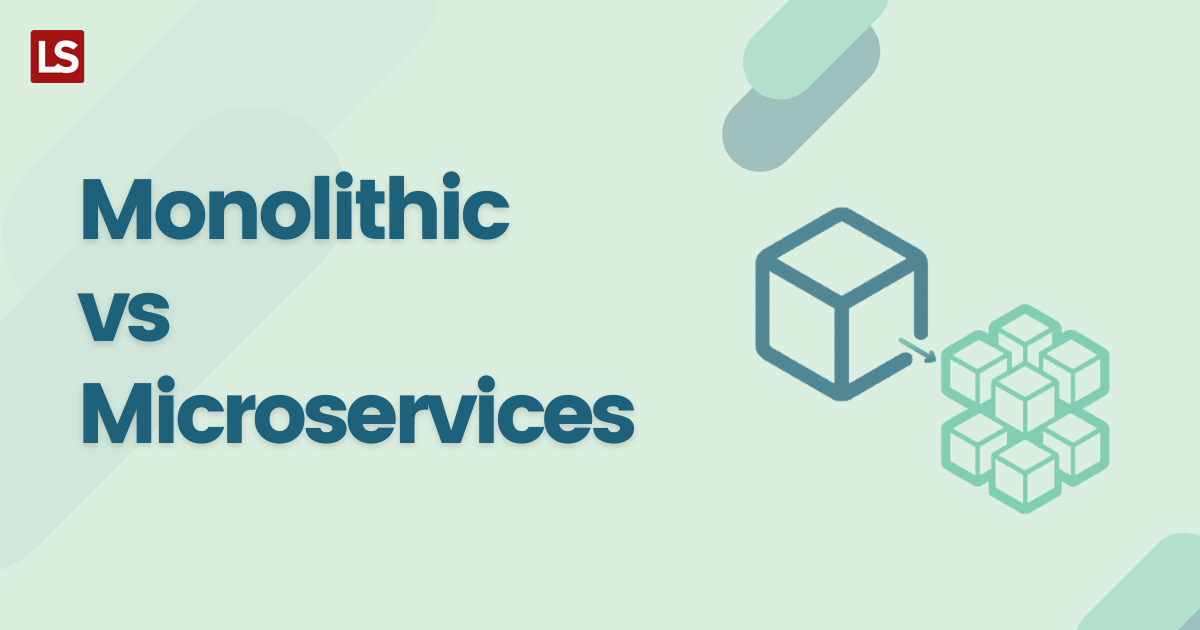“Monolithic vs. microservices” has been a debatable topic from as early as 2005 when microservices or service oriented architecture came into being and ever since has been steadily consolidating its market share to become a preferred choice for many business organizations around the globe.
As per Wikipedia,
“In February 2020, the Cloud Microservices Market Research Report predicted that the global microservice architecture market size will increase at a Compound annual growth rate (CAGR) of 21.37% from 2019 to 2026 and reach $3.1 billion by 2026.”
No doubt Microservices are in trend these days, but it does come with some challenges like distributed databases, latency in responses when inter-communicating with two or more microservices, it also requires an expert team to set up the microservices’ architecture successfully, else it could lead to over-engineering and consequently poor application heath.
In fact, Microservices are not a 100% fit for every application. So it’s always a wise decision to identify your application requirements (both technical and financial) against the various facts instead of following the trends blindly.
Ask yourself… Does this fit you the best?
This article mainly focuses on clarifying Microservices and Monolithic concepts, discussing advantages and disadvantages with key factors of application planning and in the end, it also includes some real-time use cases that can help you make a better decision based on requirements / nature of the project.
A short description of monolithic architecture
The monolithic architecture is a traditional model that consists of interconnected modules in a single, self-contained unit.
This is the most commonly used approach where the application architecture is built with a single code base that consists of the presentational layer, business layer, database access & application integration in a single integrated application platform for all required components.
The application is not just responsible for executing a single task, but it includes an end-to-end execution of necessary steps required for completing a user request.
A quick note on Microservice architecture
It is a modern architectural style that provides flexibility to structure an application into a form of modular components & services.
It is designed to provide a service oriented architecture where each and every service is responsible for similar kind of functionality. Each service could be designed in different technologies and scaled as per requirement.
This architecture is usually well suited for enterprise applications.
Monolithic VS Microservices: The battleground

Performance & Scalability
In Monolithic architecture, external service calls to different modules are not required for small applications and this produces faster response time. However scaling large applications is usually difficult in such a framework.
In contrast, Microservices provide great flexibility to scale individual services based on their usage although it could report some latency in the request processing time where intercommunications are required between more than one microservices.
Security
Microservices are considered less secure because of its inter-services communication that expends attached surfaces. Many factors are generally considered for securing microservice systems.
On the other hand monolithic architecture eliminates these communications with inter class calls and is considered more robust & secure.
Stability of application
Microservices have an edge when we think about stability, reason being, breaking any change may only have impact on some part of application instead of downtime for complete application.
Also, with microservices, we generally have an option to quick fix and the risk of free deployment is also very small whereas with monolithic applications, each bug fix requires a complete big application deployment that contains much more risk.
Budget
Microservices require a set up with service oriented architecture where each service has its own separate resources which leads to some additional costs at both development & deployments levels.
At development level, you need to hire an experienced DevOps team who is familiar with this architecture.
At hosting level, it may require additional server resources, as it is a general practice to host each microservice separately. So, if an application has budget constraints, this factor plays a key role.
Development & Maintenance
Monolithic architecture leads to faster implementation because all the required source code is placed at the same place so implementation of a new feature or update is generally quicker without compatibility issues. However, sometimes monolithic may cause complete development blockage because of dependencies with other incomplete / ongoing modules. Also, Monolithic can be time-consuming when it comes to onboarding a new member in a large monolithic application. The Maintenance part can also be huge in case of the complex systems. It could be the opposite for the microservices.
Microservices contain only relevant feature files that are easily understandable and any new developer can be on board easily without worrying about the complete system knowledge. Also, with microservices, the next service implementation can start with prototyping the endpoint response thus the development blockages can be avoided in this framework.
Development / DevOps Team Requirement
Designing microservices based systems may require an experienced development team who can take care of things like code redundancy, data integrity and build the orchestration system of services and help with monitoring.
However with monolithic architecture since there is one single database with a single standalone code base these problems are already taken care of. Deploying a monolithic application doesn’t include so much complication. Sometimes a developer with basic DevOps skills can do both, i.e., host & deploy the monolithic applications.
Upgrade / Technology Flexibility
Technology upgrade / flexibility are other key areas which need our consideration. They are required for better security audit, up to date bug fixes / feature releases and to take advantage of multiple technologies for different modules / services.
With microservices architecture, we have flexibility to do the version / release upgrade easily without worrying about the complete system compatibility. Also, we have flexibility to take advantage of multiple technology features by designing services in different leading technologies. It also overcomes the barrier of dependency with a particular team which is only efficient to work in a single technology.
On the other hand with monolithic architecture, we have technology lock-ins, therefore selecting different technologies as well as upgrading big complex systems is quite difficult with increased risk of breaking functionality.
In short, here is the quick comparison between both
| Monolithic | Microservices | |
| Performance & scalability | Eliminates latency in response time but is hard to scale | Gives flexibility to scale individual services. |
| Security | More secure because of less surface of interactions. | Less secure |
| Application Stability | A Single bug could break the complete application, less stable. | More stable, less downtime. |
| Budget | Cost-effective development. | Huge costs involved in preparing microservices architecture & hosting. |
| Development & Maintenance | Quick to develop, hard to maintain | Long development time, easy to maintain |
| Development & DevOps Team requirements | Average | Experienced DevOps skills required to prepare the architecture |
| Technology Flexibility | No, restricted to one language | Very Flexible, Each service could be designed in different languages. |
Which suits you best?
Use monolithic architecture in case of:
1. A New business idea and would like to give it a try.
2. You are planning a small application with a small set of target audience. Like an application/ portal for a small team / company.
3. Having strict timeline & budget constraints like if your product is in the funding stage and would like to set up the application as quickly as possible with a low budget as setting up the cloud architecture could be really expensive. In short, use monolithic, in case you are planning to create a robust secure system in budget.
4. Having a small team with little experience of microservices architecture.
5. If you already have an integrated portal / framework / CMS (Shopify, WordPress, Moodle, Laravel, any internal portal etc.) to fulfill most of the application needs.
Use Microservice architecture in case:
1. Would like to build an enterprise application where you are targeting an organizational need instead of just individual. Ex. CRM, ERP etc…
2. Having a plan to engage multiple teams, define a single feature service to each team and avoid the development blockage.
3. Don’t have a strict timeline and teams have enough time to research and set up a compatible and effective system.
4. The Target audience is too broad or if you are eyeing major growth in business / application size in the future.
5. Some parts of an application need special attention or have requirements that can be filled efficiently by other technologies.
Conclusion
If your product is in the initial grooming & funding phase and you are still uncertain about the market size, it is always advisable to start with monolithic architecture to focus on creating or establishing the system first.
Once the business starts growing and you have the required resources, you can move to microservices architecture. Microservices is the best choice for established businesses and complex systems to create efficient applications.





Great Insight! & Very well put together information!
I suppose it all comes down to the business aspect & the scale of the project.
This also signifies the importance of not jumping ship on an existing paradigm just because of something new or popular in the dev industry. Each project calls for its own specific demand & is always suited by its own tailor-made architecture.